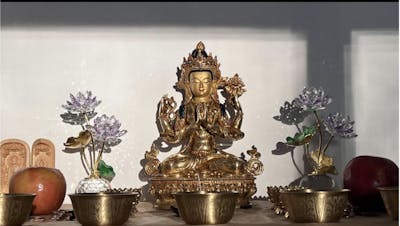-
-
Beyond Vision: The Third Eye of Indra and Cosmic WisdomRegular price $1,336.50
$1,485.00Sale price
Indra Statue
Indra Statue: Lord of Heaven and the Protector of Dharma
Nidhiratna's Indra statue captures the majestic essence of the King of the Devas and the celestial protector of the universe. Sculpted with intricate details, this masterpiece portrays Indra in a commanding yet benevolent form, holding his iconic Vajra (thunderbolt), symbolizing supreme power and divine authority.
This statue is crafted from premium materials, featuring a copper body with gold gilding and adorned with semi-precious stones. Every aspect of the design reflects the celestial grandeur of Indra, from his intricately carved armor to the delicate ornamentation representing his divine regalia.
For devotees and admirers, this statue not only serves as a representation of spiritual and cosmic balance but also as a striking piece of Himalayan artistry, exuding both reverence and beauty.
Indra: The Vedic King of Heaven
Indra, known as Śakra in Buddhist traditions, is one of the most revered deities in Vedic and early Buddhist cosmology. As the lord of the heavens and the protector of the eastern direction, Indra is often depicted as a powerful warrior and a guardian of the Dharma.
Indra is deeply associated with rain, thunder, and lightning, embodying both the life-giving aspects of nature and its formidable power. In Buddhist contexts, Indra supports the Buddha and protects the teachings, ensuring their preservation and propagation.
Symbolism and Attributes of Indra
Indra’s depiction is rich in symbolism, embodying his celestial role and spiritual significance:
- Vajra (Thunderbolt): The Vajra is Indra’s weapon of choice, symbolizing unyielding power and the ability to overcome obstacles. It also represents the indestructible truth of Dharma.
- Elephant Airavata: Indra’s mount, the celestial elephant Airavata, represents strength, wisdom, and the cosmic balance of nature.
- Crown and Jewelry: Indra’s crown and ornaments signify his royal status among the Devas and his role as a protector of the divine order.
- Rain and Clouds: Indra’s association with rain signifies his role as a life-sustainer, nourishing the earth and its beings.
- Posture and Mudra: Indra is often depicted in a regal and dynamic posture, reflecting his role as a warrior and a guardian.
Indra in Buddhist Lore
In Buddhist texts, Indra is seen as a devotee and supporter of the Buddha. He often appears in stories, such as aiding the Buddha by providing protection during meditations or offering alms.
One of the most famous episodes involving Indra is his role in the "Indra's Net" metaphor, symbolizing the interconnectedness of all phenomena. In this teaching, the net's infinite reflections represent the interdependent nature of reality.
The Practice of Revering Indra
Indra’s presence in spiritual practices serves as a reminder of the need for strength, resilience, and cosmic balance. His qualities inspire practitioners to act with courage, uphold truth, and protect the Dharma.
His mantra is often recited to invoke blessings of power, wisdom, and protection:
Om Śakra Deva Namaha
This mantra calls upon Indra’s divine attributes, fostering inner strength and clarity in the face of challenges.
A Symbol of Divine Leadership and Protection
The Indra statue is more than a work of art—it is a spiritual emblem of power, wisdom, and balance. Whether placed in a sacred space or admired for its artistic excellence, this statue inspires devotion and reverence for the cosmic protector and guardian of Dharma.
Through his legacy and teachings, Indra remains a symbol of divine leadership, reminding us of the eternal balance between strength and compassion, action and wisdom.






































